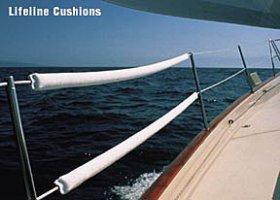Frank Langer
1984 Ericson 30+, Nanaimo, BC
I have checked the archives, but still would appreciate more or updated information on advantages and disadvantages of coated vs. uncoated lifelines. The information I have so far says that uncoated is now required in offshore races due to concern that the PVC coated lifelines are more prone to rust and the rust can`t be seen. Also that insurance companies may eventually required uncoated wire for the same reason. As well, the uncoated lines are a bit cheaper, stay cleaner, can be more easily monitored for any `fishhooks`.
My wife is a bit concerned that the wire lifelines will be harder on the hands when going forward to the bow, and will be more uncomfortable when she is sitting with her feet hanging over the beam edge and leaning on the lifeline with her elbows up--one of her favourite postures in fair weather.
We are leaning towards the uncoated wire lifelines, but are wondering if there is anything we may be overlooking. Any opinions would be appreciated--I have read previous posts, but they focus more on the issue of having them done professionally vs. doing them ourselves. We have decided to have a rigging shop do them for us to ensure good quality.
Thanks,
Frank
My wife is a bit concerned that the wire lifelines will be harder on the hands when going forward to the bow, and will be more uncomfortable when she is sitting with her feet hanging over the beam edge and leaning on the lifeline with her elbows up--one of her favourite postures in fair weather.
We are leaning towards the uncoated wire lifelines, but are wondering if there is anything we may be overlooking. Any opinions would be appreciated--I have read previous posts, but they focus more on the issue of having them done professionally vs. doing them ourselves. We have decided to have a rigging shop do them for us to ensure good quality.
Thanks,
Frank

